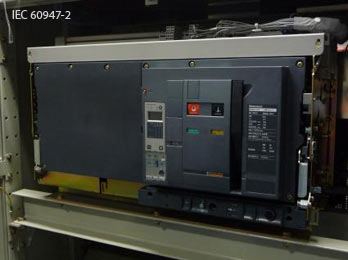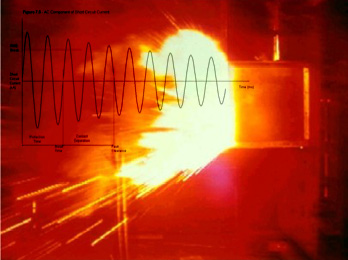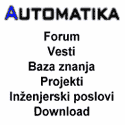
Standard IEC 60947-2 | Circuit Breakers
This standard applies to circuit-breakers, the main contacts of which are intended to be connected to circuits, the rated voltage of which does not exceed 1000 VAC or 1500 VDC.; it also contains additional requirements for integrally fused circuit-breakers.
It applies whatever the rated currents, the method of construction or the proposed applications of the circuit-breakers may be.
Changes in dependability needs and technologies have led to a marked increase in standard requirements for industrial circuit-breakers.
Conformity with standard IEC 947-2, renamed IEC 60947-2 in 1997, can be considered as an ‘all-risk’ insurance for use of circuit-breakers. This standard has been approved by all countries.
The principles
Standard IEC 60947-2 is part of a series of standards defining the specifications for LV electrical switchgear:
- the general rules IEC 60947-1, that group the definitions, specifications and tests common to all LV industrial switchgear.
- the product standards IEC 60947-2 to 7, that deal with specifications and tests specific to the product concerned. Standard IEC 60947-2 applies to circuit-breakers and their associated trip units. Circuit-breaker operating data depend on the trip units or relays that control their opening in specific conditions.
This standard defines the main data of industrial circuit-breakers:
- their classification: utilisation category, suitability for isolation, etc.
- the electrical setting data
- the information useful for operation
- the design measures
- coordination of protection devices
The standard also draws up series of conformity tests to be undergone by the circuitbreakers. These tests, which are very complete, are very close to real operating conditions. Conformity of these tests with standard IEC 60947-2 is verified by accredited laboratories.
Table of main data (appendix K IEC 60947-2):

Circuit-breaker category
Category IEC 60947-2 defines two circuit-breaker categories:
- category A circuit-breakers, for which no tripping delay is provided. This is normally the case of moulded case circuit-breakers. These circuit-breakers can provide current discrimination.
- category B circuit-breakers, for which, in order to provide time discrimination, tripping can be delayed (up to 1 s) for all short-circuits of value less than the current Icw.
This is normally the case of power or moulded case circuit-breakers with high ratings. For circuit-breakers installed in the MSBs, it is important to have an lcw equal to lcu in order to naturally provide discrimination up to full ultimate breaking capacity Icu.
Reminders of standard-related electrical data
The setting data are given by the tripping curves. These curves contain some areas limited by the following currents.

- Rated operational current (In)
In (in A rms) = maximum uninterrupted current withstood at a given ambient temperature without abnormal temperature rise.
E.g. 125 A at 40 °C - Adjustable overload setting current (lr)
Ir (in A rms) is a function of ln. lr characterises overload protection. For operation in overload, the conventional non-tripping currents lnd and tripping currents ld are:- Ind = 1.05 Ir
- Id = 1.30 Ir
Id is given for a conventional tripping time. For a current greater than ld, tripping by thermal effect will take place according to an inverse time curve. Ir is known as Long Time Protection (LTP).
Short time tripping setting current (Isd)
Isd (in kA rms) is a function of Ir. lsd characterises short-circuit protection. The circuit breaker opens according to the short time tripping curve:
- either with a time delay tsd,
- or with constant I2t,
- or instantaneously (similar to instantaneous protection).
Isd is known as Short Time Protection or lm.
- Instantaneous tripping setting current (Ii)
Ii (in kA) is given as a function of ln. It characterises the instantaneous short-circuit protection for all circuit-breaker categories. For high overcurrents (short-circuits) greater than the li threshold, the circuit-breaker must immediately break the fault current.
.
This protection device can be disabled according to the technology and type of circuit-breaker (particularly B category circuit-breakers).

Table for calculation of asymmetrical short-circuits (IEC 60947.2 para. 4.3.5.3.)

- Rated short-circuit making capacity(*) (Icm)
Icm (peak kA) is the maximum value of the asymmetrical short-circuit current that the circuit-breaker can make and break. For a circuit-breaker, the stress to be managed is greatest on closing on a short-circuit. - Rated ultimate breaking capacity(*) (Icu)
Icu (kA rms) is the maximum short-circuit current value that the circuit-breaker can break. It is verified according to a sequence of standardised tests. After this sequence, the circuit-breaker must not be dangerous. This characteristic is defined for a specific voltage rating Ue. - Rated service breaking capacity(*) (Ics)
Ics (kA rms) is given by the manufacturer and is expressed as a % of Icu. This performance is very important as it gives the ability of a circuit-breaker to provide totally normal operation once it has broken this short-circuit current three times. The higher Ics, the more effective the circuit-breaker. - Rated short time withstand current(*) (Icw)
Defined for B category circuit-breakers
Icw (kA rms) is the maximum short-circuit current that the circuit-breaker can withstand for a short period of time (0.05 to 1 s) without its properties being affected. This performance is verified during the standardised test sequence.
.
(*) These data are defined for a specific voltage rating Ue.
Circuit-breaker coordination
The term coordination concerns the behaviour of two devices placed in series in electrical power distribution in the presence of a short-circuit.

Discrimination and cascading can only be guaranteed by the manufacturer who will record his tests in tables.
IEC 60947-2 Summary
Standard IEC 60947.2 specifies the main data of Industrial Circuit-Breakers:
- the utilisation category
- the setting data
- the design measures
- etc.
It draws up a series of very complete tests representative of circuit-breaker real operating conditions.
SOURCE: Schneider Electric
.
Related articles

Short Circuit Parameters in Low Voltage AC Circuits
Low-voltage equipment standards IEC60947 and IEC60439 currently include short-circuit ratings for products and assemblies respectively, defined in terms of the ability of the equipment to operate at a level of peak current, an RMS current for a specified time and/or a level of current conditional upon a short-circuit protective device in series. In practice the correct application of the various short-circuit ratings needs to be fully understood by the circuit designer to avoid leaving a circuit or equipment with inadequate short-circuit protection. It is also useful to take full advantage of the capability of devices and systems to avoid over-engineering, with the consequent unnecessary additional cost. This guide does not concern itself with the issue of selectivity between devices in series, which must be considered separately.
Principles of Application
The Installation
In order to ensure the capability of equipment under short-circuits conditions the circuit designer must firstly have available the prospective fault level at the point of installation of each item of equipment. This is produced by a system protection study. IEC60781 provides an application guide for calculation of short-circuit currents in lowvoltage radial systems. Short-circuit parameters are defined by this guide in terms, which include the following:
- Prospective (available) short-circuit current:
The current that would flow if the short-circuit were replaced by an ideal connection of negligible impedance without any change of the supply. - Peak short-circuit current Ip
The maximum possible instantaneous value of the prospective (available) short-circuit current. - Symmetrical short-circuit breaking current Ib
The r.m.s. value of an integral cycle of the symmetrical a.c. component of the prospective (available) shortcircuit current at the instant of contact separation of the first pole of a switching device. - Steady-state short-circuit current Ik
The r.m.s. value of the short-circuit current which remains after the decay of the transient phenomena.
- unlimited
- limited by an SCPD (short-circuit protective device)
LV Assemblies (switchboard, distribution board etc.)
An assembly will have a short-circuit rating, assigned by the manufacturer, defined in terms of the maximum prospective fault level applicable at the point it is connected into the system.
This will have been determined by test and/or design calculations as specified in the assembly standard, IEC60439-1, or applicable part thereof.
The terminology to define the short-circuit rating of an assembly is given in the standard as follows:
- Rated short-time current (Icw) (of a circuit of an assembly)
Summarised as: The r.m.s value of short-time current that a circuit of an assembly can carry without damage under specified test conditions, defined in terms of a current and time e.g. 20kA, 0,2s. - Rated peak withstand current (Ipk) (of a circuit of an assembly)
Summarised as: The value of peak current that a circuit can withstand satisfactorily under specified test conditions. - Rated conditional short-circuit current (Icc) (of a circuit of an assembly)
Summarised as: The value of prospective short-circuit current that a circuit, protected by a specified shortcircuit protective device (SCPD), can withstand satisfactorily for the operating time of that device, under specified test conditions. Note: the short-circuit protective device may form an integral part of the assembly or may be a separate unit.An assembly may be assigned a value of Icc alone.
- An assembly may be assigned values of Icw and Ipk (but cannot be assigned a value of Icw or Ipk alone).
- An assembly may be assigned values of Icw, Ipk and Icc.
- An assembly may be assigned different values of Icc for different circuit protective devices and/or system voltages.
- An assembly may be assigned different values of Icw for different short-time periods e.g. 0.2s, 1s, 3 s.
Switchgear
In terms of short-circuit capability switchgear must be considered in respect of it’s function in the particular application. A switching device is considered in two respects, self-protection and use as a short-circuit protective device (SCPD) where applicable.
Switchgear – Self Protection Against Short Circuit
Two cases are considered:
- Load and overload switching alone, without any short-circuit switching capability:
In this case the switching device will be short-circuit rated on a similar basis to a circuit of an assembly (see above), with a rating of Icw and/or a conditional short-circuit rating, but will in addition have a rated short-circuit making capacity Icm. - Load, overload and short-circuit switching capability:
- Fused switchgear – in this case the short-circuit breaking function is provided by the integral fuses and the device will have a conditional short-circuit rating
- Circuit breakers – the circuit-breaker will be self-protecting up to its breaking capacity rating (see later). At fault levels above the breaking capacity rating a circuit-breaker may be capable of operating with ‘back-up’ protection by an SCPD (this is in effect a conditional rating, but the term is not generally used in this context).
Switchgear – Application as SCPD
- Fused Switchgear and Fuses as SCPD
Since the short-circuit breaking function in fused switchgear is provided by the fuses it is the fuse characteristics that are considered. These are given in IEC60269-1 as follows:- Breaking capacity of a fuselink
- value (for a.c. the r.m.s. value of the a.c. component) of prospective current that a fuselink is capable of breaking at a stated voltage under prescribed conditions. - Cut-off current
Summarised as: maximum instantaneous value reached by the current during the breaking operation of a fuselink when it operates to prevent the current reaching the prospective peak. - Operating I²t (Joule integral)
Summarised as: Integral of the square of the current over the operating time of the fuse.
Sometimes referred to as ‘energy let-through’. When expressed in A²t gives the energy dissipated per ohm and thus represents the thermal effect on the circuit.
- Circuit-breakers as SCPD
- Moulded-case circuit-breakers (MCCBs) and air circuit-breakers (ACBs) are rated according to IEC60947-2 as follows
- Rated short-circuit making capacity (Icm)
Summarised as: The maximum peak prospective current that the circuit-breaker can make on to satisfactorily.
- Rated short-circuit breaking capacities:
- Rated ultimate short-circuit breaking capacity (Icu)
Summarised as: The r.m.s prospective current that the circuit breaker is capable of breaking at a specified voltage under defined test conditions, which include one break and one make/break operations. - Rated service short-circuit breaking capacity (Ics)
Summarised as: The r.m.s prospective current that the circuit breaker is capable of breaking at a specified voltage under defined test conditions, which include one break and two make/break operations. The standard specifies fixed relationships to Icu of 25, 50, 75 or 100%. - Rated short-time withstand current (Icw)
Summarised as: The r.m.s value of short-time current assigned by the manufacturer based on specified test conditions. Minimum values are given in the standard.
A circuit-breaker can only be assigned a rated short-time withstand current Icw if it is equipped with a time-delay overcurrent release.
All circuit-breakers to IEC60947-2 will have values of Icu and Ics.
Characteristics of circuit-breakers not mandated in IEC60947-2 but having application to short-circuit protection:
- Cut-off current
The maximum instantaneous value reached by the current during the breaking operation of a circuit-breaker when it operates to prevent the current reaching the prospective peak. - Operating I²t (Joule integral)
Integral of the square of the current over the operating time of the circuit-breaker on a short-circuit. Sometimes referred to as ‘energy let-through’. When expressed in A²t gives the energy dissipated per ohm and thus represents the thermal effect on the circuit.
Examples of the Practical Application of the Product Characteristics
In simple studies only the r.m.s value of steady-state short-circuit current (Ik) is quoted. The peak current is assumed to be in a standard relationship to the r.m.s current, determined by the overall power factor, and taken into account in the rating of SCPDs to the respective IEC standards.
Circuit Protection
The application of short-circuit protective devices (SCPD) to circuit protection i.e. the protection of cables, is detailed in the installation rules, IEC364. In general it is accepted that selection of the protective device on the basis of thermal protection of a cable automatically provides short-circuit protection up to the breaking capacity of the SCPD, in the case of non-time-delayed devices.
Short-Circuit Protection for LV assemblies
Switchboard/Motor-Control Centre
The prospective short-circuit current at the input to the switchboard is obtained from a system protection study.
This will be given as an r.m.s value.
- If the switchboard has an Icw current value higher than the prospective current level then the only requirement is to limit the time for which a short-circuit could persist to within the short-time value. This is achieved by the setting of releases upstream or at the incomer to the switchboard.
- If the switchboard has an Icc rating higher than the prospective current level then the only requirement is to include the specified SCPD in the circuit. This may be added in the circuit upstream or may already be included as an incomer to the switchboard.
Busbar Trunking (BBT)
The prospective short-circuit current at the input to the switchboard is obtained from a system protection study.
This will be given as an r.m.s value.
- If the BBT has an Icw current value higher than the prospective short circuit current level then the only requirement is to limit the time for which a short-circuit could persist to within the short-time value. This is achieved by the time-delay setting of overcurrent releases upstream.
- If the BBT has an Icw lower than the prospective short circuit current level Ik but has an Icc rating higher than Ik then the only requirement is to include the specified SCPD in the circuit upstream or in the end-feed unit. The suitability of any given SCPD may be derived from the cut-off current and Joule-integral characteristics by comparison with proof-test parameters.
Motor Control Gear (MCG)
Motor starters and contactors are not generally self-protecting against the effects of short-circuit and therefore need to be associated with an SCPD. In this particular case test procedures to IEC60947-4-1 recognise the difficulty of protecting sensitive devices from damage under heavy short-circuit conditions. Thus a special case of conditional rating is obtained which allows two classes of co-ordination with an SCPD:
Type 1 – in which a certain amount of damage to the MCG is accepted.
Type 2 – in which the MCG is capable of further use.
These ratings can only be obtained by type-testing and thus the data must be obtained from the manufacturer of the SCPD or the MCG.
Miniature Circuit Breakers (MCBs)
When applied in other than domestic (household) situations the short-circuit capability of MCBs to IEC60898 is often inadequate and they need to be ‘backed-up’ by another SCPD. Details of how the appropriate SCPD is determined are given, for circuit-breakers, in Appendix A of IEC60947-2. Basically this shows that only testing of the required combination is satisfactory and thus the data must be obtained from the manufacturer of the SCPD or the MCB. The same applies to fuses used as SCPD.
Izvor: www.voltimum.co.uk
.
Related articles












